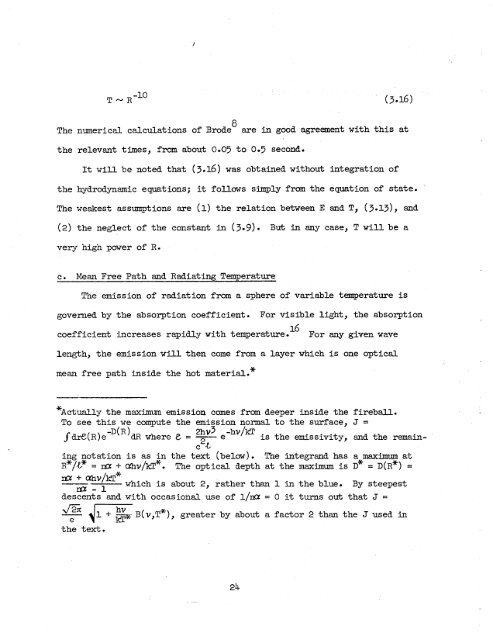Theory of the Fireball
Theory of the Fireball
Theory of the Fireball
You also want an ePaper? Increase the reach of your titles
YUMPU automatically turns print PDFs into web optimized ePapers that Google loves.
T-R -10<br />
(3.16)<br />
8<br />
The numerical calculations <strong>of</strong> Brode are in good agreement with this at<br />
<strong>the</strong> relevant times, from about 0.05 to 0.5 second.<br />
It will be noted that (3.16) was obtained without integration <strong>of</strong><br />
<strong>the</strong> hydrodynamic equations; it follows simply from <strong>the</strong> equation <strong>of</strong> state.<br />
The weakest assumptions are (1) <strong>the</strong> relation between E and T, (3.13), and<br />
(2) <strong>the</strong> neglect <strong>of</strong> <strong>the</strong> constant in (3.9) . But in any case, T will be a<br />
very hign power <strong>of</strong> R.<br />
C. Mean Free Path and Radiating Temperature<br />
The emission <strong>of</strong> radiation from a sphere <strong>of</strong> variable temperature is<br />
governed by <strong>the</strong> absorption coefficient. For visible light, <strong>the</strong> absorption<br />
coefficient increases rapidly with temperature. For any given wave<br />
length, tine emission w ill <strong>the</strong>n come from a layer which is one optical<br />
mean free path inside <strong>the</strong> hot material.*<br />
*Actually <strong>the</strong> maximum emission comes from deeper inside <strong>the</strong> fireball.<br />
To see this we compute <strong>the</strong> ernigsion normal to <strong>the</strong> surface, J =<br />
2hv3 e -hv@<br />
jdr@(R)e -D(R)dE? where e = - is <strong>the</strong> emissivity, and <strong>the</strong> remain-<br />
C2.e<br />
ing notation is as in <strong>the</strong> text (below). The integrand has a maximum at<br />
R"/$* = a + cuhv/fl*. The optical depth at <strong>the</strong> maximum is D* = D(R*) =<br />
ncu + @nv'kir* which is about 2, ra<strong>the</strong>r than 1 in <strong>the</strong> blue. By steepest<br />
a-1<br />
descents and with occasional use <strong>of</strong> 1/m = 0 it turns out that J =<br />
e 4- B( v,T*), greater by about a factor 2 than <strong>the</strong> J used in<br />
<strong>the</strong> text.<br />
24<br />
16
















